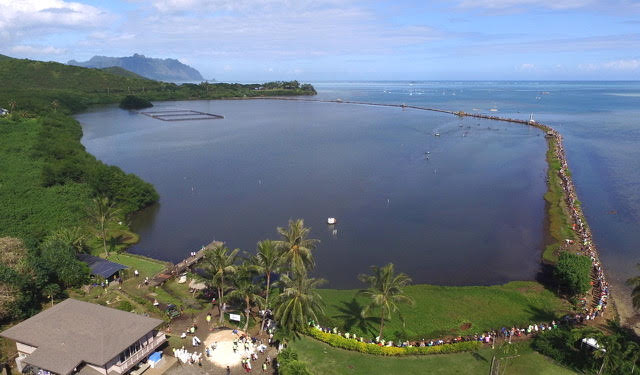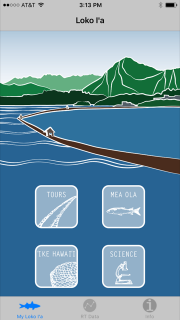Loko I‘a app puts a Native Hawaiian fishpond in the palm of your hand
 A community event at He‘eia Fishpond in Kaneohe Bay on Oahu. Credit: Paepae o He‘eia
A community event at He‘eia Fishpond in Kaneohe Bay on Oahu. Credit: Paepae o He‘eia
A National Science Foundation innovation grant to has spawned a second generation Hawaiian fishpond mobile app. The newly released Loko I‘a 2.0 iPhone app allows users to explore He‘eia fishpond on ‘Oahu, Hawai‘i through guided on-site and virtual tours, photos, narration, natural history, culture, and science. The app was created by Dr. Judith Lemus of the University of Hawai‘i at Mānoa (UHM) Hawai‘i Institute of Marine Biology (HIMB), Marion Ano of Purple Mai’a Foundation, the staff of Paepae o He’eia, and in collaboration with Dr. Brian Glazer of the Oceanography Department.
The new version, funded through a National Science Foundation I-Corps for Learning grant to Lemus and Ano, includes access to real-time data from Glazer’s water quality sensors in the native Hawaiian fishpond, sections on Mea Ola (pond life) and ‘Ike Hawai‘i (Hawaiian knowledge), as well as all new graphics and images. Expanded virtual and walking tours also allow users to explore even more of the pond.
“The goal of the app is to promote technology-enabled, place-based learning and to highlight the integration of science, traditional knowledge, and cultural practice to help restore Hawaiian fishponds,” said Lemus, who first received grants for this project from the NSF and the Hawaii Community Foundation. The new award provided funding to incorporate several technological and design upgrades into the app, as well as training on business model development for educational innovations.

Loko I’a app homescreen
The team wanted to create an educational tool that promotes learning from a holistic perspective that is usable by both teachers and community members. The app highlights efforts at He‘eia fishpond as a model for community engagement and successful integration of science and traditional knowledge systems. It also promotes the ecological and cultural value of Hawaiian fishponds.
Walled Hawaiian fishponds, or loko i‘a, are exemplars of traditional Hawaiian engineering, technology, and resource management. Sometimes called the “Hawaiian refrigerator,” they were used to attract, grow, and store herbivorous fish for community sustenance. Previously common along shallow coastlines, especially on the windward side of O‘ahu, very few remain today due to land development, sedimentation, or neglect. Several of those still in existence are now managed by dedicated community organizations like Paepae o He‘eia, with plans to restore these fishponds to their original function. Researchers at UH are assisting with some of these efforts by applying new technologies and methods to help better understand and address modern-made problems like anoxia and eutrophication.




